Chain block inspection
The inspection of chain blocks is a critical aspect within the lifting equipment and crane sector. Chain blocks are pivotal components in ensuring safe operations across various industries such as construction, manufacturing, and logistics. They are typically used for heavy-duty lifting tasks where precision and reliability are paramount.
Chain blocks consist of a series of interlocking links that form a chain, which is attached to the load by means of shackles or hooks. The block itself contains pulleys designed to reduce the force required to lift a load. This mechanical advantage is achieved through the principle of leverage and friction reduction provided by the rollers in the pulley system.
Given their importance, regular inspections are essential to maintain safety standards. These inspections should be conducted by qualified personnel using appropriate equipment and following established guidelines. The inspection process involves checking for signs of wear, corrosion, or damage that could compromise the integrity of the chain block. Common issues include rusting, deformation, cracks in the load path components, and misalignment of pulleys.
There are several standards that guide the inspection processes for lifting equipment including chain blocks. For instance, ISO 4309:2016 specifies requirements for wire rope slings, which indirectly apply to chain blocks due to their similar mechanical principles. Additionally, EN 1758:2012 provides specific requirements and tests for crane and lifting accessories, covering aspects relevant to chain block safety.
During the inspection, it is crucial to ensure that the chain block operates smoothly without any binding or excessive noise. This smooth operation indicates proper lubrication levels and functioning components. Lubricants play a vital role in reducing wear between moving parts but must be chosen carefully to avoid affecting the integrity of the load path.
The lifespan of a chain block can vary significantly based on factors like environmental conditions, frequency of use, and maintenance practices. Proper inspection helps extend its useful life by identifying potential issues early. Regular inspections also contribute to compliance with regulatory requirements set forth by bodies such as OSHA (Occupational Safety and Health Administration) in the United States.
For industries where safety is non-negotiable—such as offshore oil drilling or construction projects—it’s imperative that chain blocks undergo thorough inspection before each use. This precautionary measure ensures not only compliance with industry standards but also protects workers from accidents caused by faulty equipment.
Why It Matters
The importance of inspecting chain blocks cannot be overstated, especially considering the potential risks associated with their failure during operation. A single malfunction can lead to catastrophic failures resulting in severe injuries or fatalities. The consequences extend beyond human safety; they also impact productivity and reputation.
- Human Safety: Chain block malfunctions pose significant threats to personnel working around them. Accidents involving heavy loads can cause serious bodily harm or even death.
- Productivity: Downtime due to equipment failure leads to lost production time, increased costs for repairs, and potential delays in project timelines.
- Reputation: Repeated incidents of equipment failures may damage the reputation of both companies involved directly with the inspection process and those relying on their services or products.
In addition to these tangible impacts, there are also intangible considerations such as maintaining a culture of safety within organizations. Regular inspections foster an environment where proactive measures towards preventing accidents become second nature among staff members.
From a legal standpoint, compliance with regulations is crucial to avoid penalties and lawsuits stemming from negligent maintenance practices. By adhering to strict inspection protocols, businesses can demonstrate due diligence in safeguarding their workforce and stakeholders.
International Acceptance and Recognition
The inspection of chain blocks has gained widespread acceptance across various countries worldwide as part of broader safety initiatives for lifting equipment. Many nations have adopted international standards to ensure consistent quality and reliability globally.
ISO 4309:2016, which pertains to wire rope slings but is applicable by extension to similar components like chain blocks, sets out comprehensive guidelines regarding design, manufacturing processes, and testing methods. This standard emphasizes the importance of regular inspections to detect early signs of deterioration that may otherwise go unnoticed.
EN 1758:2012 provides detailed specifications for crane and lifting accessories, including specific requirements concerning chain blocks. It covers aspects such as load ratings, installation instructions, maintenance procedures, and报废





